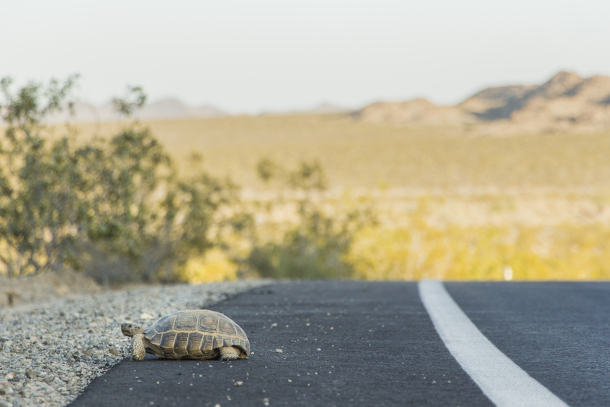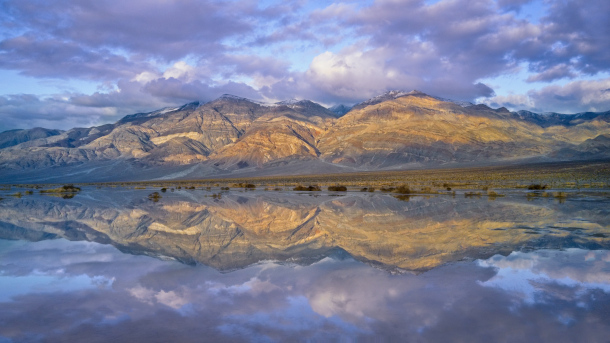Reopening National Parks
Air Date: Week of June 5, 2020

During the months Joshua Tree National Park was closed, there was less vehicle traffic, which allowed desert tortoises a safer road crossing. (Photo: Brad Sutton, NPS, Flickr, Public Domain)
During the coronavirus pandemic lockdown, most National Parks closed their doors to visitors, allowing wildlife including bears, pronghorn, and desert tortoises to venture into usually-crowded areas of the parks. As parks gradually reopen for the summer season, NPS employees are working to keep animals and visitors safe. Kati Schmidt, the Director of Communications for the National Parks Conservation Association, joined Host Steve Curwood to discuss the challenges of reopening National Parks amidst the coronavirus pandemic.
Transcript
CURWOOD: There are more than 400 parks and other public spaces administered by the US National Park system, and most were closed as the pandemic surged. Warmer weather and the urge to get outside in nature as an antidote to the confinement of quarantine is pushing the park system to open up more now, though it seems the animals in many parks did not miss us. Rangers in national parks including Yosemite, Rocky Mountain and Death Valley report seeing wildlife temporarily reclaim some spaces typically full of visitors. But now the National Park Service has to find ways to re-open which will keep the animals, visitors and staff safe as the pandemic continues. Kati Schmidt is Director of Communications at the National Parks Conservation Association.
SCHMIDT: With the national parks being closed in places across the country for varying amounts of time up to, you know, two months, some even longer, it really gave an opportunity for the long term, you know, full time inhabitants of our national parks, the wildlife, to really come out. And for example, in Death Valley National Park, a herd of pronghorn antelope, they were found as low as the Furnace Creek area of the park, which is normally a very busy area of Death Valley and somewhere where a lot of colleagues had shared that this was unprecedented--that they had never seen pronghorn in that area of Death Valley before.
CURWOOD: So Great Smoky National Park is, I believe, the most visited National Park and therefore I guess the critters there would all of a sudden say wait, nobody's here. Which of those critters came out to be seen by you know those few rangers that were still there?

Picture of a black bear in Yosemite National Park. (Photo: Dave Toussaint, Flickr, CC BY NC 2.0)
SCHMIDT: You know, there were reports of black bear moms and cubs coming out of hibernation and being seen in what are normally high traffic public areas of the park. From a wildlife perspective, if you think about animals like bears that do have a longer lifespan that could be the first time in years that they are coming out in the spring season to not have hordes of cars driving by with their cameras out.
CURWOOD: Now what's been seen in the West there, what about Yellowstone? What critters are venturing out that are not seen nearly as often as have been seen in these past couple of months.
SCHMIDT: In Grand Teton in Yellowstone, the famous grizzly bear 399 and her new set of cubs were recently seen coming out of hibernation in the park. Down in Joshua Tree National Park park rangers were reporting especially during the park closures, a lot of desert tortoise coming out of their boroughs and finding some sunshine on roadways. Now, during the park closures finding sunshine on roadways seemed like a pretty good idea if you're a desert tortoise looking for a hot place to hang out, but obviously during normal times, that would be kind of a kiss of death for a desert tortoise. So Joshua Tree has done a really great job at educating visitors as they enter the park. They have little tortoise shaped flashing signals of you know slow down look out for tortoise. Desert tortoise is one of more than 600 protected species under the Endangered Species Act that have habitat in our national parks. So it's really important to think about protections for those animals and also the bigger role that protecting an animal in its habitat has on protecting the bigger park ecosystem.
CURWOOD: As the parks open, to what extent are they getting overwhelmed by people just eager to get out of quarantine?
SCHMIDT: You know, Memorial Day weekend was really a wake up call. We saw up at Grand Canyon a line of cars outside of the entrance to get in. The park only had their entrance gates open for four hours in the morning and really limited opportunities. As parks reopen we're concerned that in some cases they are reopening too soon and we're concerned in many cases that we're not sure whether the parks have the proper equipment PPE within the National Park to help serve their stuff and to ensure visitor safety. A number that continues to stick with me is that in the entire Morongo Basin surrounding Joshua Tree National Park, there are only four ICU beds. So many national park communities are really kind of more isolated from urban centers, so there is a lot of concern for both park staff as well as surrounding communities if parks do reopen too soon.

In Death Valley National Park, pronghorns have been spotted near park headquarters, where they are typically not seen. (Photo:Jim Choate, Flickr, CC BY-NC-ND 2.0)
CURWOOD: I noticed that in the past year, Yosemite Valley had to limit the amount of visitors due to high levels actually of littering and even human waste that were along the entrance roads, especially the south entrance. So this begs the question: Should the national parks limit the amount of visitors allowed to enter the parks in order to avoid issues such as excessive trash, overwhelming the rangers and for that matter, overwhelming animals who act as if maybe they could use more of the territory that they’re allotted?
SCHMIDT: The idea of you know, parks being loved to death has been kind of a narrative of the last several years. But as some parks have started to reopen, we've seen some proposals of parks putting in different timed entry protocols in place. Rocky Mountain is the first National Park that did get approved to do some timed entry as they reopen the park. You would buy a ticket for a specific time and day. And that allows the parks to monitor both days that are busier and also be able to space things out a bit and to hopefully ensure that when people go to parks like Yosemite, they're actually able to not just spend the whole time sitting in stopped traffic, but actually get out of their cars and enjoy the wonderful features.
CURWOOD: Kati Schmidt is Director of Communications at the National Parks Conservation Association. Kati, thanks so much for taking the time with us today.
SCHMIDT: Thanks so much for having me, Steve.
Links
The Guardian | “‘We’ve Never Seen This’: Wildlife Thrives in Closed US National Parks”
Learn more about the bipartisan bill: The Great American Outdoors Act
Click here for more information of when National Parks are reopening
Living on Earth wants to hear from you!
Living on Earth
62 Calef Highway, Suite 212
Lee, NH 03861
Telephone: 617-287-4121
E-mail: comments@loe.org
Newsletter [Click here]
Donate to Living on Earth!
Living on Earth is an independent media program and relies entirely on contributions from listeners and institutions supporting public service. Please donate now to preserve an independent environmental voice.
NewsletterLiving on Earth offers a weekly delivery of the show's rundown to your mailbox. Sign up for our newsletter today!
 Sailors For The Sea: Be the change you want to sea.
Sailors For The Sea: Be the change you want to sea.
 The Grantham Foundation for the Protection of the Environment: Committed to protecting and improving the health of the global environment.
The Grantham Foundation for the Protection of the Environment: Committed to protecting and improving the health of the global environment.
 Contribute to Living on Earth and receive, as our gift to you, an archival print of one of Mark Seth Lender's extraordinary wildlife photographs. Follow the link to see Mark's current collection of photographs.
Contribute to Living on Earth and receive, as our gift to you, an archival print of one of Mark Seth Lender's extraordinary wildlife photographs. Follow the link to see Mark's current collection of photographs.
 Buy a signed copy of Mark Seth Lender's book Smeagull the Seagull & support Living on Earth
Buy a signed copy of Mark Seth Lender's book Smeagull the Seagull & support Living on Earth

